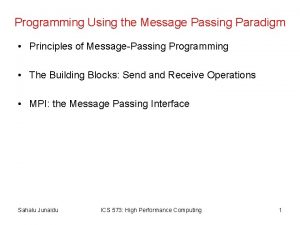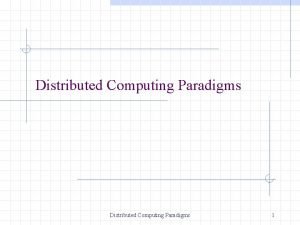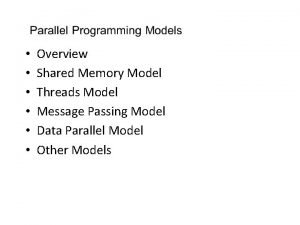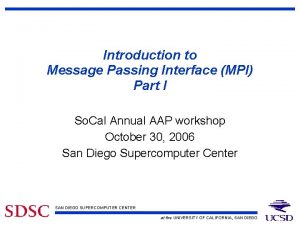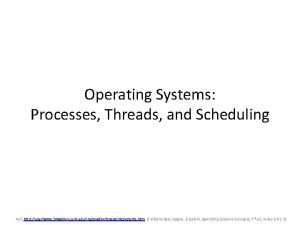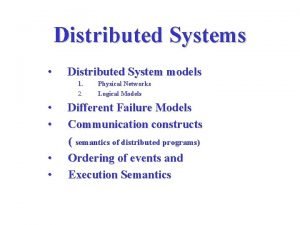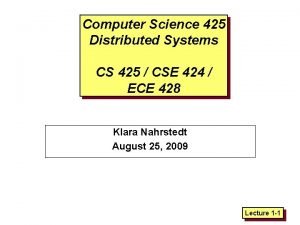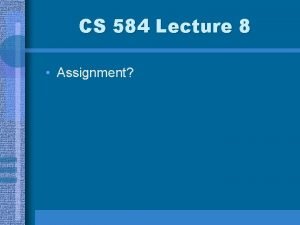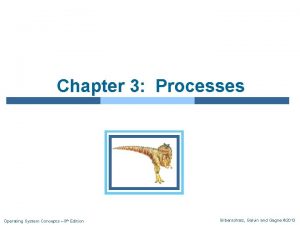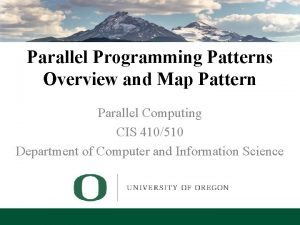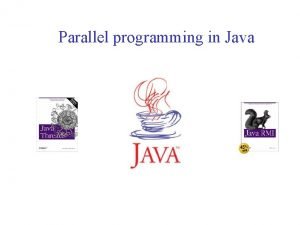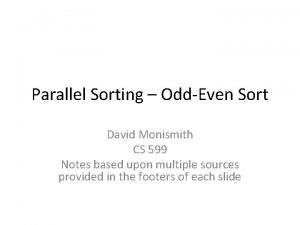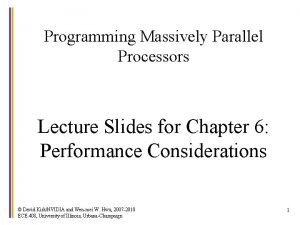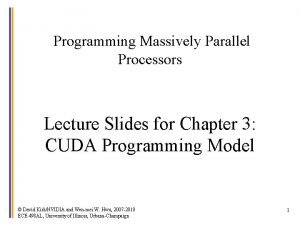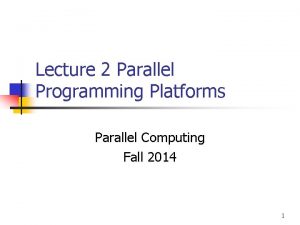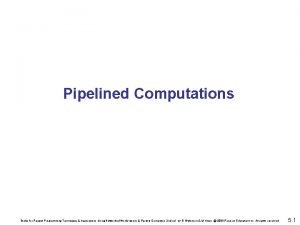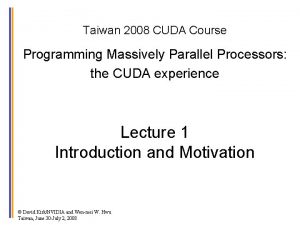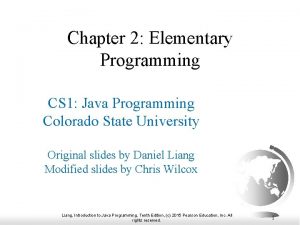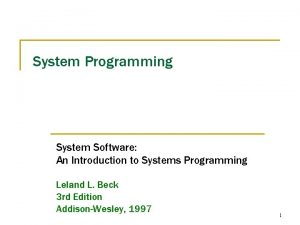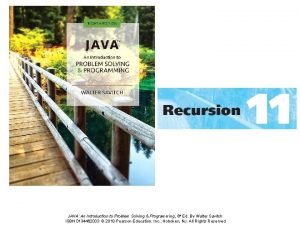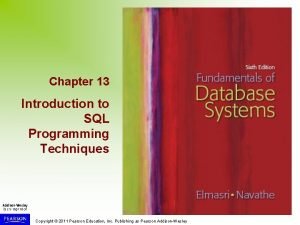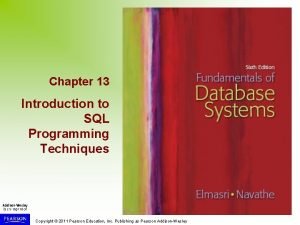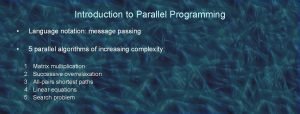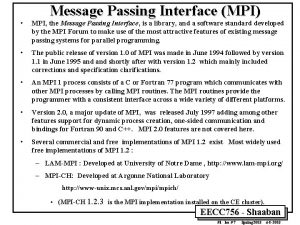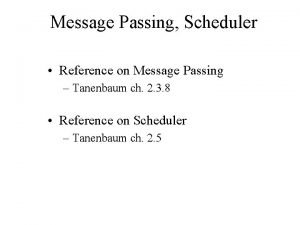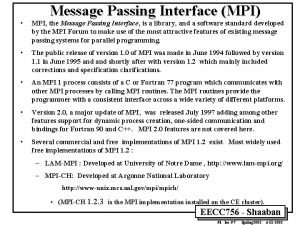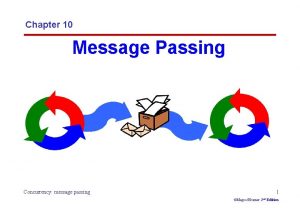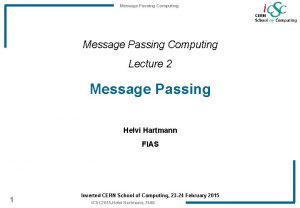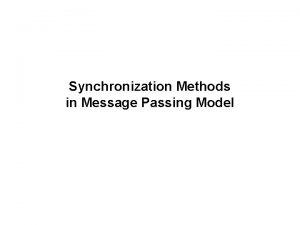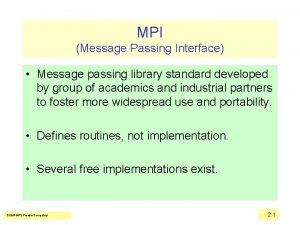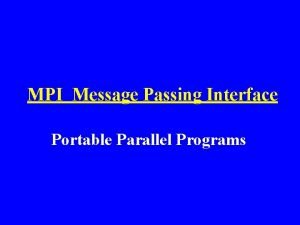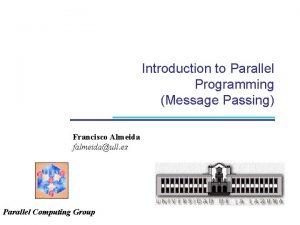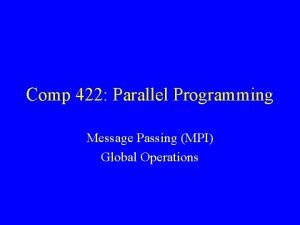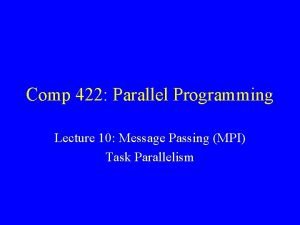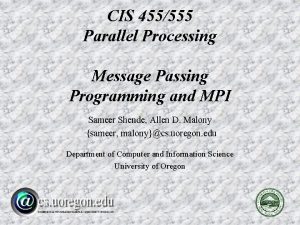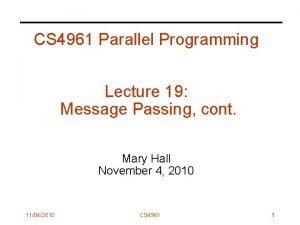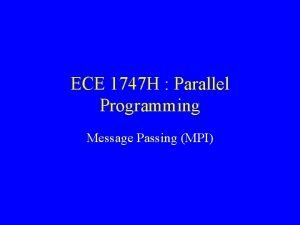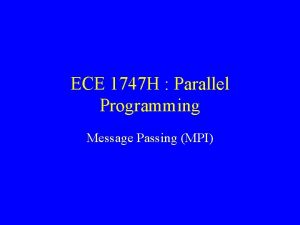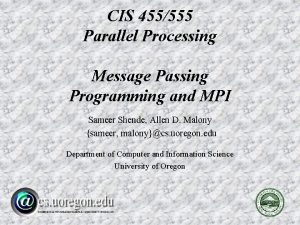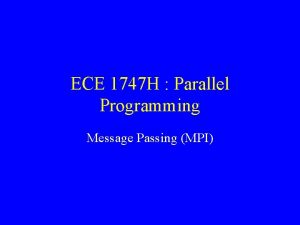Introduction to Parallel Programming Language notation message passing






![Structure Master • Master A[N, *] C[1, 1] distributes the C[N, N] B[*, 1] Structure Master • Master A[N, *] C[1, 1] distributes the C[N, N] B[*, 1]](https://slidetodoc.com/presentation_image_h2/44ec5caef4b1f6ab144c3e2c7e7b274f/image-7.jpg)



![Structure A[1, *] B[*, *] Slave 1 Master C[1, *] A[N, *] …. C[N, Structure A[1, *] B[*, *] Slave 1 Master C[1, *] A[N, *] …. C[N,](https://slidetodoc.com/presentation_image_h2/44ec5caef4b1f6ab144c3e2c7e7b274f/image-11.jpg)



![Parallel Algorithm 3 (master) Master (processor 0): int result [N, N / P]; int Parallel Algorithm 3 (master) Master (processor 0): int result [N, N / P]; int](https://slidetodoc.com/presentation_image_h2/44ec5caef4b1f6ab144c3e2c7e7b274f/image-15.jpg)
![Parallel Algorithm 3 (slave) Slaves: int A[N / P, N], B[N, N], C[N / Parallel Algorithm 3 (slave) Slaves: int A[N / P, N], B[N, N], C[N /](https://slidetodoc.com/presentation_image_h2/44ec5caef4b1f6ab144c3e2c7e7b274f/image-16.jpg)




![Successive Over relaxation (SOR) float G[1: N, 1: M], Gnew[1: N, 1: M]; for Successive Over relaxation (SOR) float G[1: N, 1: M], Gnew[1: N, 1: M]; for](https://slidetodoc.com/presentation_image_h2/44ec5caef4b1f6ab144c3e2c7e7b274f/image-21.jpg)






![Parallel SOR float G[lb-1: ub+1, 1: M], Gnew[lb-1: ub+1, 1: M]; for (step = Parallel SOR float G[lb-1: ub+1, 1: M], Gnew[lb-1: ub+1, 1: M]; for (step =](https://slidetodoc.com/presentation_image_h2/44ec5caef4b1f6ab144c3e2c7e7b274f/image-28.jpg)































![Parallel TSP Algorithm (1/3) process master (CPU 0): generate-jobs([]); /* generate all jobs, start Parallel TSP Algorithm (1/3) process master (CPU 0): generate-jobs([]); /* generate all jobs, start](https://slidetodoc.com/presentation_image_h2/44ec5caef4b1f6ab144c3e2c7e7b274f/image-60.jpg)













- Slides: 73

Introduction to Parallel Programming • • Language notation: message passing Distributed-memory machine – – • All machines are equally fast E. g. , identical workstations on a network 5 parallel algorithms of increasing complexity: – – – Matrix multiplication Successive overrelaxation All-pairs shortest paths Linear equations Traveling Salesman problem

Message Passing • SEND (destination, message) – blocking: wait until message has arrived (like a fax) – non blocking: continue immediately (like a mailbox) • RECEIVE (source, message) • RECEIVE-FROM-ANY (message) – blocking: wait until message is available – non blocking: test if message is available

Syntax • • Use pseudo-code with C-like syntax Use indentation instead of {. . } to indicate block structure Arrays can have user-defined index ranges Default: start at 1 – int A[10: 100] runs from 10 to 100 – int A[N] runs from 1 to N • Use array slices (sub-arrays) – A[i. . j] = elements A[ i ] to A[ j ] – A[i, *] = elements A[i, 1] to A[i, N] – A[*, k] = elements A[1, k] to A[N, k] i. e. row i of matrix A i. e. column k of A

Parallel Matrix Multiplication • Given two N x N matrices A and B • Compute C = A x B • Cij = Ai 1 B 1 j + Ai 2 B 2 j +. . + Ai. NBNj A B C

Sequential Matrix Multiplication for (i = 1; i <= N; i++) for (j = 1; j <= N; j++) C [i, j] = 0; for (k = 1; k <= N; k++) C[i, j] += A[i, k] * B[k, j]; The order of the operations is over specified Everything can be computed in parallel

Parallel Algorithm 1 Each processor computes 1 element of C Requires N 2 processors Each processor needs 1 row of A and 1 column of B
![Structure Master Master AN C1 1 distributes the CN N B 1 Structure Master • Master A[N, *] C[1, 1] distributes the C[N, N] B[*, 1]](https://slidetodoc.com/presentation_image_h2/44ec5caef4b1f6ab144c3e2c7e7b274f/image-7.jpg)
Structure Master • Master A[N, *] C[1, 1] distributes the C[N, N] B[*, 1] B[*, N] work and receives the Slave results 2 N 1 • Slaves get work execute it • Master distributes work and receivesand results A[1, *] …. • Slaves (1. . P) get work and execute • it Slaves are numbered • How to start up master/slave processes depends on consecutively Operating System from 1 to P

Master (processor 0): Parallel Algorithm int proc = 1; for (i = 1; i <= N; i++) for (j = 1; j <= N; j++) SEND(proc, A[i, *], B[*, j], i, j); proc++; for (x = 1; x <= N*N; x++) RECEIVE_FROM_ANY(&result, &i, &j); C[i, j] = result; Slaves (processors 1. . P): int Aix[N], Bxj[N], Cij; RECEIVE(0, &Aix, &Bxj, &i, &j); Cij = 0; for (k = 1; k <= N; k++) Cij += Aix[k] * Bxj[k]; SEND(0, Cij , i, j); 1

Efficiency (complexity analysis) • Each processor needs O(N) communication to do O(N) computations – Communication: 2*N+1 integers = O(N) – Computation per processor: N multiplications/additions = O(N) • Exact communication/computation costs depend on network and CPU • Still: this algorithm is inefficient for any existing machine • Need to improve communication/computation ratio

Parallel Algorithm 2 Each processor computes 1 row (N elements) of C Requires N processors Need entire B matrix and 1 row of A as input
![Structure A1 B Slave 1 Master C1 AN CN Structure A[1, *] B[*, *] Slave 1 Master C[1, *] A[N, *] …. C[N,](https://slidetodoc.com/presentation_image_h2/44ec5caef4b1f6ab144c3e2c7e7b274f/image-11.jpg)
Structure A[1, *] B[*, *] Slave 1 Master C[1, *] A[N, *] …. C[N, *] B[*, *] Slave N

Parallel Algorithm Master (processor 0): for (i = 1; i <= N; i++) SEND (i, A[i, *], B[*, *], i); for (x = 1; x <= N; x++) RECEIVE_FROM_ANY (&result, &i); C[i, *] = result[*]; Slaves: int Aix[N], B[N, N], C[N]; RECEIVE(0, &Aix, &B, &i); for (j = 1; j <= N; j++) C[j] = 0; for (k = 1; k <= N; k++) C[j] += Aix[k] * B[j, k]; SEND(0, C[*] , i); 2

Problem: need larger granularity Each processor now needs O(N 2) communication and O(N 2) computation -> Still inefficient Assumption: N >> P (i. e. we solve a large problem) Assign many rows to each processor

Parallel Algorithm 3 Each processor computes N/P rows of C Need entire B matrix and N/P rows of A as input Each processor now needs O(N 2) communication and O(N 3 / P) computation
![Parallel Algorithm 3 master Master processor 0 int result N N P int Parallel Algorithm 3 (master) Master (processor 0): int result [N, N / P]; int](https://slidetodoc.com/presentation_image_h2/44ec5caef4b1f6ab144c3e2c7e7b274f/image-15.jpg)
Parallel Algorithm 3 (master) Master (processor 0): int result [N, N / P]; int inc = N / P; /* number of rows per cpu */ int lb = 1; /* lb = lower bound */ for (i = 1; i <= P; i++) SEND (i, A[lb. . lb+inc-1, *], B[*, *], lb+inc-1); lb += inc; for (x = 1; x <= P; x++) RECEIVE_FROM_ANY (&result, &lb); for (i = 1; i <= N / P; i++) C[lb+i-1, *] = result[i, *];
![Parallel Algorithm 3 slave Slaves int AN P N BN N CN Parallel Algorithm 3 (slave) Slaves: int A[N / P, N], B[N, N], C[N /](https://slidetodoc.com/presentation_image_h2/44ec5caef4b1f6ab144c3e2c7e7b274f/image-16.jpg)
Parallel Algorithm 3 (slave) Slaves: int A[N / P, N], B[N, N], C[N / P, N]; RECEIVE(0, &A, &B, &lb, &ub); for (i = lb; i <= ub; i++) for (j = 1; j <= N; j++) C[i, j] = 0; for (k = 1; k <= N; k++) C[i, j] += A[i, k] * B[k, j]; SEND(0, C[*, *] , lb);

Comparison Algori thm Parallelism (#jobs) Communication per job Computation Ratio per job comp/comm 1 N 2 N+ N+1 N O(1) 2 N N + N 2 +N N 2 O(1) 3 P N 2/P + N 2/P N 3/P O(N/P) • If N >> P, algorithm 3 will have low communication overhead • Its grain size is high

Example speedup graph

Discussion • Matrix multiplication is trivial to parallelize • Getting good performance is a problem • Need right grain size • Need large input problem

Successive Over relaxation (SOR) Iterative method for solving Laplace equations Repeatedly updates elements of a grid
![Successive Over relaxation SOR float G1 N 1 M Gnew1 N 1 M for Successive Over relaxation (SOR) float G[1: N, 1: M], Gnew[1: N, 1: M]; for](https://slidetodoc.com/presentation_image_h2/44ec5caef4b1f6ab144c3e2c7e7b274f/image-21.jpg)
Successive Over relaxation (SOR) float G[1: N, 1: M], Gnew[1: N, 1: M]; for (step = 0; step < NSTEPS; step++) for (i = 2; i < N; i++) /* update grid */ for (j = 2; j < M; j++) Gnew[i, j] = f(G[i, j], G[i-1, j], G[i+1, j], G[i, j-1], G[i, j+1]); G = Gnew;

SOR example

SOR example

Parallelizing SOR • Domain decomposition on the grid • Each processor owns N/P rows • Need communication between neighbors to exchange elements at processor boundaries

SOR example partitioning

SOR example partitioning

Communication scheme Each CPU communicates with left & right neighbor (if existing)
![Parallel SOR float Glb1 ub1 1 M Gnewlb1 ub1 1 M for step Parallel SOR float G[lb-1: ub+1, 1: M], Gnew[lb-1: ub+1, 1: M]; for (step =](https://slidetodoc.com/presentation_image_h2/44ec5caef4b1f6ab144c3e2c7e7b274f/image-28.jpg)
Parallel SOR float G[lb-1: ub+1, 1: M], Gnew[lb-1: ub+1, 1: M]; for (step = 0; step < NSTEPS; step++) SEND(cpuid-1, G[lb]); /* send 1 st row left */ SEND(cpuid+1, G[ub]); /* send last row right */ RECEIVE(cpuid-1, G[lb-1]); /* receive from left */ RECEIVE(cpuid+1, G[ub+1]); /* receive from right */ for (i = lb; i <= ub; i++) /* update my rows */ for (j = 2; j < M; j++) Gnew[i, j] = f(G[i, j], G[i-1, j], G[i+1, j], G[i, j-1], G[i, j+1]); G = Gnew;

Performance of SOR Communication and computation during each iteration: • Each CPU sends/receives 2 messages with M reals • Each CPU computes N/P * M updates The algorithm will have good performance if • Problem size is large: N >> P • Message exchanges can be done in parallel Question: • Can we improve the performance of parallel SOR by using a different distribution of data?

Example: block-wise partitioning CPU 1 CPU 2 CPU 3 • Each CPU gets a SQRT(N) by SQRT(N) block of data (assuming N=M) CPU 16 • • • Each CPU needs sub-rows/columns from 4 neighbors Row-wise: only 2 messages, but with N elements Block-wise: 4 messages, with only SQRT(N) elements Best partitioning depends on machine/network ! More on this at HPF lecture

All-pairs Shorts Paths (ASP) • Given a graph G with a distance table C: C [ i , j ] = length of direct path from node i to node j • Compute length of shortest path between any two nodes in G

Floyd's Sequential Algorithm • Basic step: • During iteration k, you can visit only intermediate nodes in the set {1. . k} • k=0 => initial problem, noiteration intermediate for (k = 1; k <= N; k++) • During k, younodes can visit only intermediate nodes for (i = 1; i <= N; i++) in the set => {1. . final k} solution • k=N for (j = 1; j <= N; j++) C [ i , j ] = MIN ( C [i, j], • k=0 => initial problem, no intermediate nodes. C [i , k] +C [k, j]); • k=N => final solution

Parallelizing ASP • Distribute rows of C among the P processors • During iteration k, each processor executes C [i, j] = MIN (C[i , j], C[i, k] + C[k, j]); on its own rows i, so it needs these rows and row k • Before iteration k, the processor owning row k sends it to all the others




Parallel ASP Algorithm int lb, ub; /* lower/upper bound for this CPU */ int row. K[N], C[lb: ub, N]; /* pivot row ; matrix */ for (k = 1; k <= N; k++) if (k >= lb && k <= ub) /* do I have it? */ row. K = C[k, *]; for (proc = 1; proc <= P; proc++) /* broadcast row */ if (proc != myprocid) SEND(proc, row. K); else RECEIVE_FROM_ANY(&row. K); /* receive row */ for (i = lb; i <= ub; i++) /* update my rows */ for (j = 1; j <= N; j++) C[i, j] = MIN(C[i, j], C[i, k] + row. K[j]);

Performance Analysis ASP Per iteration: • 1 CPU sends P -1 messages with N integers • Each CPU does N/P x N comparisons Communication/ computation ratio is small if N >> P

. . . but, is the Algorithm Correct?

Parallel ASP Algorithm int lb, ub; /* lower/upper bound for this CPU */ int row. K[N], C[lb: ub, N]; /* pivot row ; matrix */ for (k = 1; k <= N; k++) if (k >= lb && k <= ub) /* do I have it? */ row. K = C[k, *]; for (proc = 1; proc <= P; proc++) /* broadcast row */ if (proc != myprocid) SEND(proc, row. K); else RECEIVE_FROM_ANY(&row. K); /* receive row */ for (i = lb; i <= ub; i++) /* update my rows */ for (j = 1; j <= N; j++) C[i, j] = MIN(C[i, j], C[i, k] + row. K[j]);

Non-FIFO Message Ordering Row 2 may be received before row 1

FIFO Ordering Row 5 may be received before row 4

Correctness Problems: • Asynchronous non-FIFO SEND • Messages from different senders may overtake each other Solution is to use a combination of: • Synchronous SEND (less efficient) • Barrier at the end of outer loop (extra communication) • Order incoming messages (requires buffering) • RECEIVE (cpu, msg) (more complicated)

Introduction to Parallel Programming • • Language notation: message passing Distributed-memory machine – • (e. g. , workstations on a network) 5 parallel algorithms of increasing complexity: – – – Matrix multiplication Successive overrelaxation All-pairs shortest paths Linear equations Traveling Salesman problem

Linear equations • Linear equations: a 1, 1 x 1 + a 1, 2 x 2 + …a 1, nxn = b 1. . . an, 1 x 1 + an, 2 x 2 + …an, nxn = bn • Matrix notation: Ax = b • Problem: compute x, given A and b • Linear equations have many important applications Practical applications need huge sets of equations

Solving a linear equation • Two phases: Upper-triangularization -> U x = y Back-substitution -> x • Most computation time is in uppertriangularization 1. . . . • Upper-triangular matrix: 01. . . 001. . . U [i, i] = 1 0001. . 00001. . . U [i, j] = 0 if i > j 000001. . 0000001. 00000001

Sequential Gaussian elimination • Converts Ax = b into Ux = y for (k = 1; k <= N; k++) for (j = k+1; j <= N; j++) • Sequential algorithm uses 3 operations 2/3 N A[k, j] = A[k, j] / A[k, k] y[k] = b[k] / A[k, k] 1. . . . A[k, k] = 1 0. . . for (i = k+1; i <= N; i++) for (j = k+1; j <= N; j++) A[i, j] = A[i, j] - A[i, k] * A[k, j] 0. . . . b[i] = b[i] - A[i, k] * y[k] A[i, k] = 0 A y

Parallelizing Gaussian elimination • Row-wise partitioning scheme Each cpu gets one row (striping ) Execute one (outer-loop) iteration at a time • Communication requirement: During iteration k, cpus Pk+1 … Pn-1 need part of row k This row is stored on CPU Pk -> need partial broadcast (multicast)

Communication

Performance problems • • • Communication overhead (multicast) Load imbalance CPUs P 0…PK are idle during iteration k Bad load balance means bad speedups, as some CPUs have too much work In general, number of CPUs is less than n Choice between block-striped & cyclic-striped distribution Block-striped distribution has high load-imbalance Cyclic-striped distribution has less load-imbalance

Block-striped distribution • CPU 0 gets first N/2 rows • CPU 1 gets last N/2 rows • CPU 0 has much less work to do • CPU 1 becomes the bottleneck

Cyclic-striped distribution • CPU 0 gets odd rows • CPU 1 gets even rows • CPU 0 and 1 have more or less the same amount of work

Traveling Salesman Problem (TSP) • Find shortest route for salesman among given set of cities (NP-hard problem) • Each city must be visited once, no return to initial city New York 2 1 Chicago 2 3 Saint Louis 4 3 7 Miami

Sequential branch-and-bound • Structure the entire search space as a tree, sorted using nearest-city first heuristic n 2 3 2 c s m 1 4 1 3 3 s m c m s 3 3 m s 4 4 m c 1 4 c 1 c s

Pruning the search tree • Keep track of best solution found so far (the “bound”) • Cut-off partial routes >= bound n 2 2 c Length=6 =6 3 s m 1 4 1 3 3 s m c m s 3 3 m 4 s Can be pruned 4 m c 4 c 1 1 c Can be s pruned

Parallelizing TSP • Distribute the search tree over the CPUs • Results in reasonably large-grain jobs n 2 3 2 c s m 1 4 1 3 3 s m c m s 3 3 m CPU 1 s 4 4 m CPU 2 c 4 1 c s CPU 3

Distribution of the tree • Static distribution: each CPU gets fixed part of tree – Load imbalance: subtrees take different amounts of time – Impossible to predict load imbalance statically (as for Gaussian) n 2 3 2 c s m 1 4 1 3 3 s m c m s 3 3 m s 4 4 m c 1 4 c 1 c s

Dynamic load balancing: Replicated Workers Model • Master process generates large number of jobs (subtrees) and repeatedly hands them out • Worker processes repeatedly get work and execute it • Runtime overhead for fetching jobs dynamically • Efficient for TSP because the jobs are large workers Master

Real search spaces are huge • NP-complete problem -> exponential search space • Master searches MAXHOPS levels, then creates jobs • Eg for 20 cities & MAXHOPS=4 -> 20*19*18*17 (>100, 000) jobs, each searching 16 remaining cities … … Master … Workers
![Parallel TSP Algorithm 13 process master CPU 0 generatejobs generate all jobs start Parallel TSP Algorithm (1/3) process master (CPU 0): generate-jobs([]); /* generate all jobs, start](https://slidetodoc.com/presentation_image_h2/44ec5caef4b1f6ab144c3e2c7e7b274f/image-60.jpg)
Parallel TSP Algorithm (1/3) process master (CPU 0): generate-jobs([]); /* generate all jobs, start with empty path */ for (proc=1; proc <= P; proc++) /* inform workers we're done */ RECEIVE(proc, &worker-id); /* get work request */ SEND(proc, []); /* return empty path */ generate-jobs (List path) { if (size(path) == MAXHOPS) /* if path has MAXHOPS cities … */ RECEIVE-FROM-ANY (&worker-id); /* wait for work request */ SEND (worker-id, path); /* send partial route to worker */ else for (city = 1; city <= NRCITIES; city++) /* (should be ordered) */ if (city not on path) generate-jobs(path||city) /* append city */ }

Parallel TSP Algorithm (2/3) process worker (CPUs 1. . P): int Minimum = maxint; /* Length of current best path (bound) */ List path; for (; ; ) SEND (0, myprocid) /* send work request to master */ RECEIVE (0, path); /* get next job from master */ if (path == []) exit(); /* we're done */ tsp(path, length(path)); /* compute all subsequent paths */

Parallel TSP Algorithm (3/3) tsp(List path, int length) { if (NONBLOCKING_RECEIVE_FROM_ANY (&m)) /* is there an update message? */ if (m < Minimum) Minimum = m; /* update global minimum */ if (length >= Minimum) return /* not a shorter route */ if (size(path) == NRCITIES) /* complete route? */ Minimum = length; /* update global minimum */ for (proc = 1; proc <= P; proc++) if (proc != myprocid) SEND(proc, length) /* broadcast it */ else last = last(path) /* last city on the path */ for (city = 1; city <= NRCITIES; city++) /* should be ordered */ if (city not on path) tsp(path||city, length+distance[last, city]) }

Search overhead n 2 3 2 c s m 1 4 1 3 3 s m c m s 3 3 m CPU 1 s 4 4 m CPU 2 c 4 1 c s CPU 3 Not pruned : -(

Search overhead • Path <n – m – s > is started (in parallel) before the outcome (6) of <n – c – s – m> is known, so it cannot be pruned • The parallel algorithm therefore does more work than the sequential algorithm • This is called search overhead • It can occur in algorithms that do speculative work, like parallel search algorithms • Can also have negative search overhead, resulting in superlinear speedups!

Performance of TSP • Communication overhead (small) – Distribution of jobs + updating the global bound – Small number of messages • Load imbalances – Small: does automatic (dynamic) load balancing • Search overhead – Main performance problem

Discussion Several kinds of performance overhead • Communication overhead: – communication/computation ratio must be low • Load imbalance: – all processors must do same amount of work • Search overhead: – avoid useless (speculative) computations Making algorithms correct is nontrivial • Message ordering

Designing Parallel Algorithms Source: Designing and building parallel programs (Ian Foster, 1995) (available on-line at http: //www. mcs. anl. gov/dbpp) • Partitioning • Communication • Agglomeration • Mapping

Figure 2. 1 from Foster's book

Partitioning • Domain decomposition Partition the data Partition computations on data: owner-computes rule • Functional decomposition Divide computations into subtasks E. g. search algorithms

Communication • Analyze data-dependencies between partitions • Use communication to transfer data • Many forms of communication, e. g. Local communication with neighbors (SOR) Global communication with all processors (ASP) Synchronous (blocking) communication Asynchronous (non blocking) communication

Agglomeration • Reduce communication overhead by – increasing granularity – improving locality

Mapping • On which processor to execute each subtask? • Put concurrent tasks on different CPUs • Put frequently communicating tasks on same CPU? • Avoid load imbalances

Summary Hardware and software models Example applications • Matrix multiplication - Trivial parallelism (independent tasks) • Successive over relaxation - Neighbor communication • All-pairs shortest paths - Broadcast communication • Linear equations - Load balancing problem • Traveling Salesman problem - Search overhead Designing parallel algorithms
 Principles of message passing programming
Principles of message passing programming Desirable features of message passing system
Desirable features of message passing system Tom minka
Tom minka Is a paradigm of distributed computing to provide
Is a paradigm of distributed computing to provide Message passing
Message passing Distributed operating system ppt
Distributed operating system ppt Message passing model
Message passing model Variational message passing
Variational message passing Message passing interface tutorial
Message passing interface tutorial Message passing game
Message passing game Priority scheduling
Priority scheduling Distributed system models
Distributed system models Message passing system in distributed system
Message passing system in distributed system Sunha cos
Sunha cos Shared memory linux
Shared memory linux Message passing interface
Message passing interface Message passing os
Message passing os An introduction to parallel programming peter pacheco
An introduction to parallel programming peter pacheco Hardware description language vs programming language
Hardware description language vs programming language How would 13800 volts be written in metric notation
How would 13800 volts be written in metric notation Infix equation
Infix equation Reversed polish notation
Reversed polish notation Prefix polish notation
Prefix polish notation Perbedaan linear programming dan integer programming
Perbedaan linear programming dan integer programming Greedy programming vs dynamic programming
Greedy programming vs dynamic programming System programming definition
System programming definition Linear vs integer programming
Linear vs integer programming Programing adalah
Programing adalah Programming massively parallel processors
Programming massively parallel processors Scala parallel map
Scala parallel map Parallel programming java
Parallel programming java Bubble sort mpi
Bubble sort mpi Mpi parallel programming in c
Mpi parallel programming in c Programming massively parallel processors
Programming massively parallel processors Programming massively parallel processors
Programming massively parallel processors Parallel programming platforms
Parallel programming platforms F# parallel programming
F# parallel programming Parallel programming
Parallel programming Programming massively parallel processors, kirk et al.
Programming massively parallel processors, kirk et al. Define like and unlike force
Define like and unlike force The inner terminus of the fingerprint pattern
The inner terminus of the fingerprint pattern Parallel and non parallel structure
Parallel and non parallel structure Parallel structure
Parallel structure Mary likes hiking swimming and to ride a bicycle
Mary likes hiking swimming and to ride a bicycle Pipo truth table
Pipo truth table O que é paralelismo
O que é paralelismo Introduction to server side programming
Introduction to server side programming Java introduction to problem solving and programming
Java introduction to problem solving and programming Introduction to programming languages
Introduction to programming languages Elementary programming in java
Elementary programming in java Introduction to visual basic
Introduction to visual basic What does plc stand for
What does plc stand for Java an introduction to problem solving and programming
Java an introduction to problem solving and programming Console programming
Console programming Programming language
Programming language Csc 102 pdf
Csc 102 pdf A web based introduction to programming
A web based introduction to programming Sic programming examples
Sic programming examples Chapter 1 introduction to computers and programming
Chapter 1 introduction to computers and programming C programming lectures
C programming lectures Introduction to visual basic programming
Introduction to visual basic programming Scratch programming concepts
Scratch programming concepts Python programming an introduction to computer science
Python programming an introduction to computer science Java introduction to problem solving and programming
Java introduction to problem solving and programming Chapter 1 introduction to computers and programming
Chapter 1 introduction to computers and programming Introduction to java programming 10th edition quizzes
Introduction to java programming 10th edition quizzes Introduction to sql programming techniques
Introduction to sql programming techniques Introduction to sql programming techniques
Introduction to sql programming techniques Chapter 1 introduction to computers and programming
Chapter 1 introduction to computers and programming Chapter 1 introduction to computers and programming
Chapter 1 introduction to computers and programming Us history staar test passing grade
Us history staar test passing grade Driver education signs
Driver education signs Passing stelsel
Passing stelsel Starbucks v sardarbuksh
Starbucks v sardarbuksh
